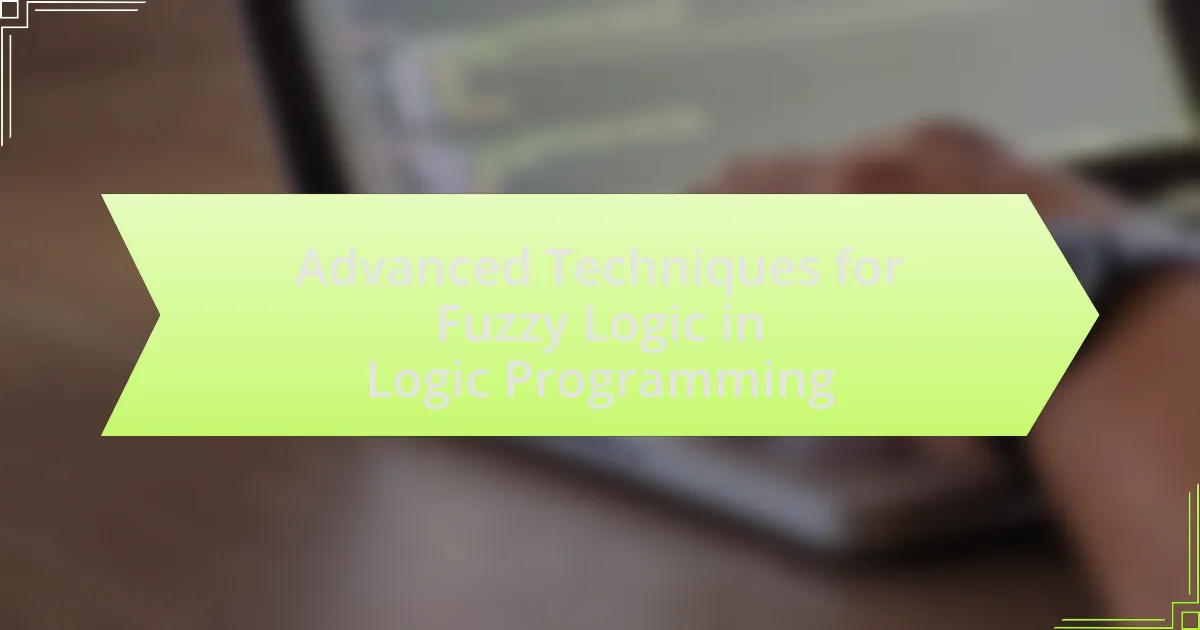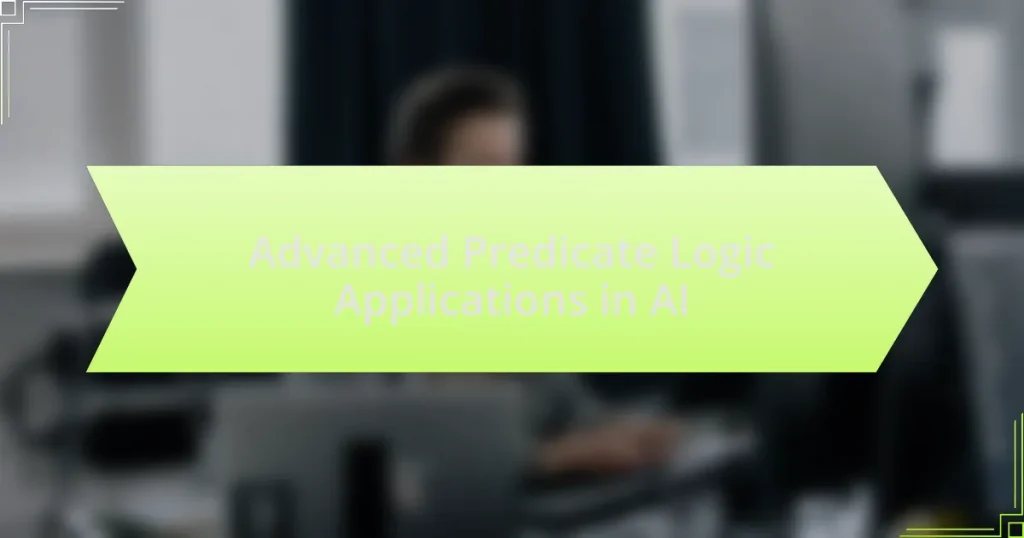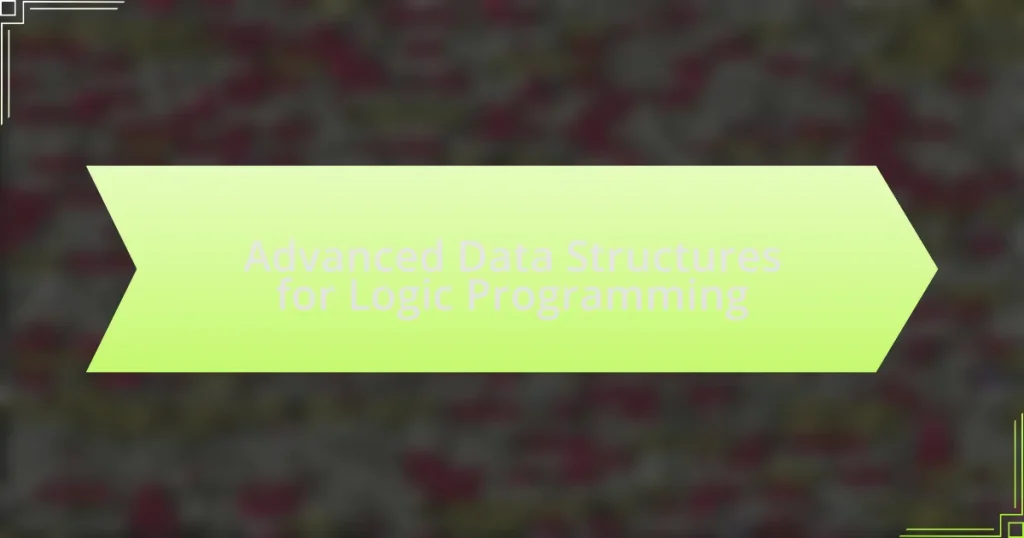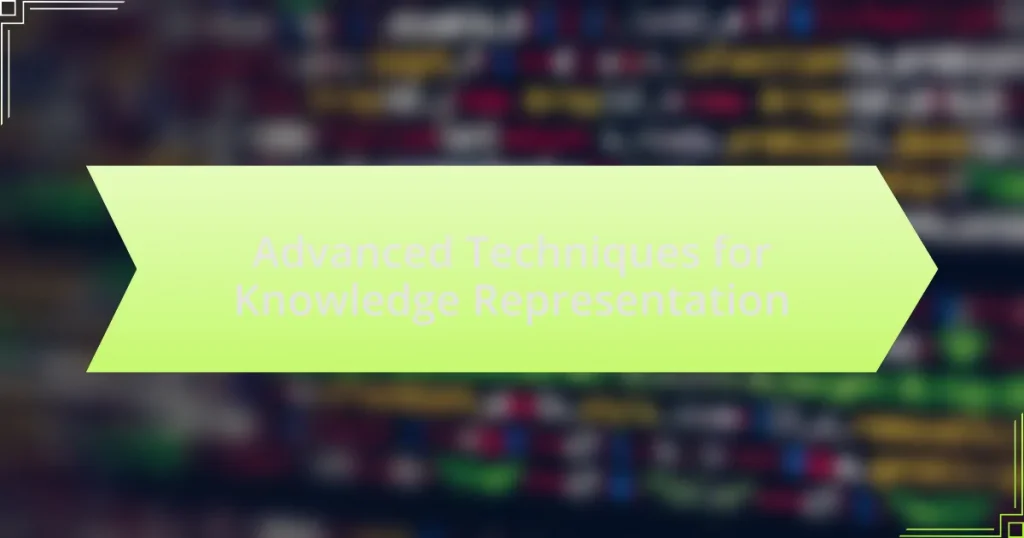The article focuses on advanced techniques for fuzzy logic in logic programming, highlighting methods such as fuzzy unification, fuzzy resolution, and the integration of fuzzy logic with probabilistic reasoning. These techniques enhance traditional logic programming by introducing flexibility and accommodating uncertainty, allowing for more nuanced decision-making in complex environments. Key components of fuzzy logic systems, including fuzzification, rule bases, and defuzzification, are discussed, along with their applications in various industries such as automotive, healthcare, and artificial intelligence. The article also addresses challenges in implementing fuzzy logic techniques and explores future trends, including the integration of machine learning and the development of hybrid systems.

What are Advanced Techniques for Fuzzy Logic in Logic Programming?
Advanced techniques for fuzzy logic in logic programming include fuzzy unification, fuzzy resolution, and the integration of fuzzy logic with other paradigms such as probabilistic reasoning. Fuzzy unification allows for the matching of fuzzy terms, enabling more flexible reasoning in uncertain environments. Fuzzy resolution extends traditional resolution methods to handle fuzzy predicates, facilitating the derivation of conclusions from fuzzy premises. The integration of fuzzy logic with probabilistic reasoning enhances decision-making processes by combining the strengths of both approaches, allowing for more nuanced interpretations of uncertainty. These techniques are validated by their application in various domains, such as expert systems and control systems, demonstrating their effectiveness in managing imprecision and vagueness in logic programming.
How do these techniques enhance traditional logic programming?
Advanced techniques for fuzzy logic enhance traditional logic programming by introducing a degree of uncertainty and flexibility in reasoning processes. These techniques allow for the representation of imprecise information, enabling systems to make decisions based on partial truths rather than binary true/false evaluations. For instance, fuzzy logic systems can handle vague concepts like “tall” or “hot,” which traditional logic programming struggles to quantify. This capability improves the applicability of logic programming in real-world scenarios, such as control systems and decision-making applications, where human-like reasoning is required. The integration of fuzzy logic has been shown to increase the robustness and adaptability of logic programming frameworks, making them more effective in complex environments.
What are the key differences between fuzzy logic and classical logic?
Fuzzy logic differs from classical logic primarily in its treatment of truth values. Classical logic operates on binary true or false values, while fuzzy logic allows for a continuum of truth values between 0 and 1, representing degrees of truth. This flexibility enables fuzzy logic to handle uncertainty and vagueness more effectively than classical logic, which is rigid and does not accommodate partial truths. For instance, in fuzzy logic, a statement can be partially true, such as “the temperature is warm,” which can be quantified as 0.7 true, whereas classical logic would require a definitive true or false classification. This distinction is crucial in applications like control systems and artificial intelligence, where real-world scenarios often involve ambiguity.
How do fuzzy logic techniques improve decision-making processes?
Fuzzy logic techniques enhance decision-making processes by allowing for reasoning with uncertain or imprecise information. These techniques enable systems to evaluate multiple criteria and handle ambiguity, which is crucial in complex decision environments. For instance, fuzzy logic can model human reasoning more closely than traditional binary logic, accommodating degrees of truth rather than a strict true/false dichotomy. This flexibility leads to more nuanced and effective decision-making, as evidenced by applications in areas such as control systems, where fuzzy logic has improved performance in managing systems like air conditioning and automotive systems by adapting to varying conditions and user preferences.
What are the main components of fuzzy logic systems?
The main components of fuzzy logic systems are fuzzification, rule base, inference engine, and defuzzification. Fuzzification converts crisp inputs into fuzzy sets, allowing for the representation of uncertainty. The rule base contains a set of fuzzy rules that define the relationships between input and output variables. The inference engine processes the fuzzy rules and derives fuzzy outputs based on the inputs. Finally, defuzzification transforms the fuzzy output back into a crisp value for decision-making. These components work together to enable fuzzy logic systems to handle imprecise information effectively.
What role do fuzzy sets play in fuzzy logic?
Fuzzy sets are fundamental to fuzzy logic as they enable the representation of uncertainty and vagueness in data. In fuzzy logic, traditional binary sets are replaced by fuzzy sets, which allow for degrees of membership, meaning an element can partially belong to a set rather than being strictly in or out. This characteristic is crucial for modeling real-world scenarios where information is often imprecise or ambiguous. For instance, in fuzzy control systems, fuzzy sets facilitate decision-making processes by allowing systems to evaluate inputs that do not fit neatly into binary categories, thus enhancing the system’s ability to handle complex and uncertain environments.
How do fuzzy rules contribute to the functionality of fuzzy logic systems?
Fuzzy rules are essential for the functionality of fuzzy logic systems as they provide a structured way to represent and process uncertain or imprecise information. These rules, typically in the form of “IF-THEN” statements, allow the system to make decisions based on degrees of truth rather than binary true/false evaluations. For instance, a fuzzy rule might state, “IF temperature is high THEN fan speed is fast,” enabling the system to adjust outputs based on varying input conditions. This flexibility is crucial in applications such as control systems, where precise numerical inputs are often unavailable. The effectiveness of fuzzy rules is supported by their ability to model human reasoning, allowing for more intuitive and adaptable decision-making processes in complex environments.
What are the applications of advanced fuzzy logic techniques in programming?
Advanced fuzzy logic techniques in programming are applied in various domains such as control systems, decision-making processes, and artificial intelligence. In control systems, fuzzy logic enhances the performance of controllers by managing uncertainty and imprecision, allowing for smoother operation in applications like temperature regulation and automotive systems. In decision-making, fuzzy logic aids in evaluating complex scenarios where binary logic falls short, such as risk assessment and medical diagnosis. Furthermore, in artificial intelligence, fuzzy logic contributes to natural language processing and machine learning by enabling systems to interpret and respond to vague or ambiguous inputs effectively. These applications demonstrate the versatility and effectiveness of advanced fuzzy logic techniques in addressing real-world challenges in programming.
How is fuzzy logic applied in artificial intelligence?
Fuzzy logic is applied in artificial intelligence to handle reasoning that is approximate rather than fixed and exact. This approach allows AI systems to make decisions based on uncertain or imprecise information, mimicking human reasoning more closely than traditional binary logic. For instance, fuzzy logic is utilized in control systems, such as those found in washing machines and air conditioners, where it adjusts operations based on varying input conditions rather than strict thresholds. Research has shown that fuzzy logic enhances decision-making processes in AI applications, improving performance in areas like pattern recognition and natural language processing, where ambiguity is prevalent.
What industries benefit from fuzzy logic in programming?
Industries that benefit from fuzzy logic in programming include automotive, telecommunications, healthcare, and finance. In the automotive industry, fuzzy logic is used in systems like anti-lock braking systems and automatic transmission control, enhancing safety and performance. Telecommunications employs fuzzy logic for network optimization and resource allocation, improving service quality. In healthcare, fuzzy logic aids in medical diagnosis and treatment planning, allowing for more personalized patient care. The finance sector utilizes fuzzy logic for risk assessment and decision-making processes, enabling better investment strategies. These applications demonstrate the versatility and effectiveness of fuzzy logic across various sectors.
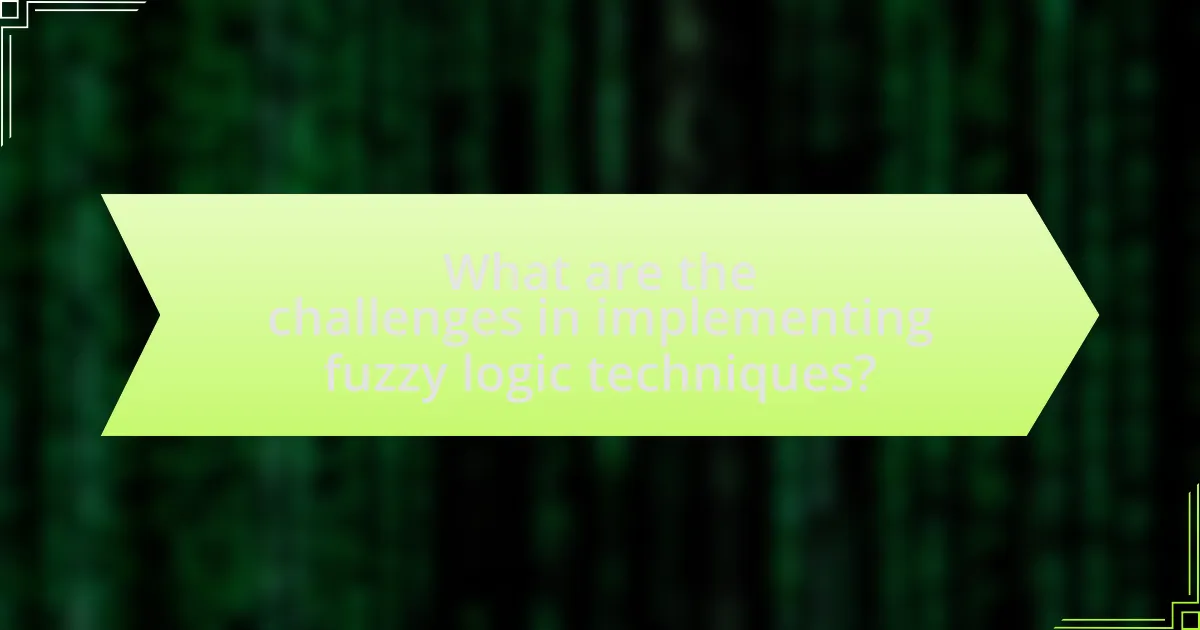
What are the challenges in implementing fuzzy logic techniques?
The challenges in implementing fuzzy logic techniques include the complexity of designing appropriate membership functions, the difficulty in tuning fuzzy rules, and the computational intensity of fuzzy inference systems. Designing membership functions requires a deep understanding of the problem domain, as poorly defined functions can lead to inaccurate results. Tuning fuzzy rules is often subjective and may require extensive experimentation to achieve optimal performance. Additionally, fuzzy inference systems can be computationally demanding, especially when dealing with large datasets or complex rule sets, which can hinder real-time applications. These challenges highlight the need for careful planning and expertise in fuzzy logic to ensure effective implementation.
What common obstacles do programmers face with fuzzy logic?
Programmers commonly face challenges with fuzzy logic, including difficulty in defining appropriate membership functions, managing computational complexity, and ensuring interpretability of results. Defining membership functions is crucial, as inaccurate definitions can lead to poor system performance; for instance, the choice of parameters directly affects the output of fuzzy inference systems. Computational complexity arises from the need to evaluate multiple rules simultaneously, which can be resource-intensive, especially in large systems. Lastly, interpretability is a significant concern, as fuzzy logic systems can produce results that are not easily understandable, making it hard for users to trust or validate the outcomes. These obstacles highlight the intricacies involved in effectively implementing fuzzy logic in programming.
How can ambiguity in fuzzy logic be managed effectively?
Ambiguity in fuzzy logic can be managed effectively through the use of clear membership functions and well-defined rules. By establishing precise membership functions, the degree of truth for each input can be accurately represented, reducing uncertainty. Additionally, employing rule-based systems that incorporate expert knowledge allows for the creation of robust inference mechanisms, which can handle ambiguous situations by providing consistent outputs based on defined criteria. Research has shown that using adaptive fuzzy systems can further enhance the management of ambiguity by dynamically adjusting membership functions based on real-time data, thereby improving decision-making processes in complex environments.
What are the limitations of fuzzy logic in complex systems?
Fuzzy logic has several limitations in complex systems, primarily related to its inability to handle uncertainty and imprecision effectively in highly dynamic environments. One significant limitation is the difficulty in defining appropriate membership functions, which can lead to ambiguity in decision-making processes. Additionally, fuzzy logic systems often struggle with scalability; as the complexity of the system increases, the number of rules and computations required can grow exponentially, making real-time processing challenging. Furthermore, fuzzy logic lacks a robust framework for integrating with probabilistic models, which are essential for managing uncertainty in complex systems. These limitations can hinder the effectiveness of fuzzy logic in applications such as autonomous systems and real-time data analysis, where precise and adaptive responses are crucial.
How can these challenges be overcome?
Challenges in implementing advanced techniques for fuzzy logic in logic programming can be overcome by adopting hybrid approaches that integrate fuzzy logic with other computational paradigms, such as neural networks or genetic algorithms. These hybrid systems enhance the adaptability and efficiency of fuzzy logic applications, allowing for better handling of uncertainty and imprecision in data. For instance, research has shown that combining fuzzy logic with neural networks can improve decision-making processes in complex environments, as demonstrated in the study “Fuzzy Neural Networks: A Survey” by Jang and Sun, which highlights the effectiveness of such integrations in various applications.
What best practices should be followed when implementing fuzzy logic?
When implementing fuzzy logic, best practices include defining clear membership functions, ensuring proper rule formulation, and validating the fuzzy inference system. Clear membership functions are essential as they determine how input values are mapped to fuzzy sets, impacting the system’s accuracy. Proper rule formulation involves creating a comprehensive set of rules that accurately reflect the relationships between inputs and outputs, which is crucial for effective decision-making. Validation of the fuzzy inference system through testing against known data ensures reliability and performance, confirming that the system behaves as expected in real-world scenarios. These practices are supported by research indicating that well-defined membership functions and robust rule sets significantly enhance the effectiveness of fuzzy logic applications in various domains.
How can tools and frameworks assist in fuzzy logic programming?
Tools and frameworks assist in fuzzy logic programming by providing structured environments that simplify the design, implementation, and testing of fuzzy systems. These tools, such as MATLAB’s Fuzzy Logic Toolbox and Python’s scikit-fuzzy, offer pre-built functions and graphical interfaces that enable users to create fuzzy inference systems without extensive programming knowledge. For instance, MATLAB’s toolbox allows for the easy visualization of fuzzy sets and rules, facilitating the understanding of complex fuzzy logic concepts. Additionally, frameworks often include simulation capabilities, which enable developers to test and refine their fuzzy logic models efficiently, leading to more robust applications in areas like control systems and decision-making processes.

What future trends are emerging in fuzzy logic and logic programming?
Future trends in fuzzy logic and logic programming include the integration of machine learning techniques, the development of hybrid systems that combine fuzzy logic with neural networks, and the increasing application of fuzzy logic in real-time data processing and decision-making systems. These trends are driven by the need for more adaptable and intelligent systems capable of handling uncertainty and imprecision in complex environments. For instance, research has shown that combining fuzzy logic with deep learning can enhance the interpretability of neural networks while maintaining their predictive power, as evidenced by studies published in journals like IEEE Transactions on Fuzzy Systems. Additionally, the rise of the Internet of Things (IoT) is pushing the boundaries of fuzzy logic applications, enabling smarter and more responsive systems in various domains such as healthcare, finance, and autonomous vehicles.
How is machine learning influencing fuzzy logic techniques?
Machine learning is significantly influencing fuzzy logic techniques by enhancing their adaptability and performance in complex decision-making scenarios. The integration of machine learning algorithms allows fuzzy systems to learn from data, improving their ability to model uncertainty and imprecision. For instance, techniques such as neuro-fuzzy systems combine neural networks with fuzzy logic, enabling the system to adjust its rules based on input data, which leads to more accurate predictions and classifications. Research has shown that these hybrid systems outperform traditional fuzzy logic models in various applications, including control systems and pattern recognition, demonstrating the effectiveness of machine learning in refining fuzzy logic methodologies.
What innovations are being developed in fuzzy logic algorithms?
Innovations in fuzzy logic algorithms include the development of adaptive fuzzy systems, which enhance decision-making processes by adjusting parameters in real-time based on input data. Researchers are also focusing on integrating fuzzy logic with machine learning techniques, allowing for improved pattern recognition and data classification. For instance, the combination of fuzzy logic with neural networks has shown significant advancements in areas such as image processing and control systems. Additionally, the implementation of fuzzy logic in the Internet of Things (IoT) is being explored to facilitate more intelligent and responsive systems. These innovations are supported by studies demonstrating increased accuracy and efficiency in various applications, such as smart home automation and autonomous vehicles.
How might fuzzy logic evolve with advancements in technology?
Fuzzy logic may evolve significantly with advancements in technology by integrating more sophisticated algorithms and machine learning techniques. As computational power increases, fuzzy logic systems can process larger datasets and make more nuanced decisions, enhancing their applicability in fields such as artificial intelligence and robotics. For instance, the incorporation of deep learning with fuzzy logic can lead to improved pattern recognition and decision-making capabilities, as evidenced by research showing that hybrid models outperform traditional methods in complex problem-solving scenarios. This evolution will likely result in more adaptive and intelligent systems capable of handling uncertainty and imprecision in real-time applications.
What practical tips can enhance the use of fuzzy logic in programming?
To enhance the use of fuzzy logic in programming, developers should focus on defining clear membership functions, as these functions are crucial for accurately representing the degrees of truth in fuzzy sets. Precise membership functions allow for better decision-making and more effective handling of uncertainty in data. Additionally, utilizing fuzzy inference systems can streamline the process of deriving conclusions from fuzzy inputs, improving the overall efficiency of the program. Implementing defuzzification techniques, such as the centroid method, can also help in converting fuzzy outputs into crisp values, which is essential for practical applications. Furthermore, continuous testing and refinement of fuzzy rules based on real-world data can lead to more robust and adaptable fuzzy logic systems.
How can developers effectively test fuzzy logic systems?
Developers can effectively test fuzzy logic systems by employing a combination of simulation, unit testing, and validation against known benchmarks. Simulation allows developers to model the fuzzy logic system’s behavior under various conditions, ensuring that the system responds as expected to different inputs. Unit testing involves creating specific test cases that cover all rules and scenarios defined in the fuzzy logic system, which helps identify any discrepancies in rule execution. Validation against known benchmarks, such as established fuzzy logic test cases or datasets, provides a reference point to assess the accuracy and reliability of the system’s outputs. This multi-faceted approach ensures comprehensive testing and enhances the robustness of fuzzy logic systems.
What resources are available for learning more about fuzzy logic techniques?
Books, online courses, and academic journals are key resources for learning about fuzzy logic techniques. Notable books include “Fuzzy Logic with Engineering Applications” by Timothy J. Ross, which provides a comprehensive introduction and practical applications of fuzzy logic. Online platforms like Coursera and edX offer courses on fuzzy logic, often created by reputable universities, allowing learners to engage with the material interactively. Additionally, journals such as “Fuzzy Sets and Systems” publish peer-reviewed articles that explore the latest research and advancements in fuzzy logic, making them valuable for both foundational knowledge and cutting-edge developments.
